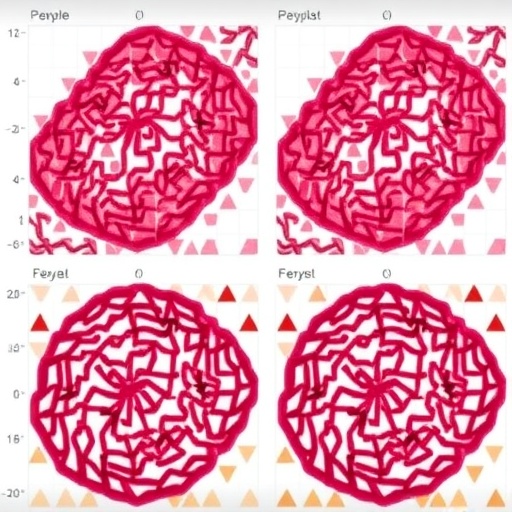In the rapidly evolving field of biomedical research, transcriptomics has emerged as a cornerstone of understanding gene expression and its implications in diseases. At the forefront of this discipline is a groundbreaking study led by Mucaki, E.J., Zhang, W., Saha, A. et al., titled “Generative and integrative modeling for transcriptomics with formalin fixed paraffin embedded material,” poised to have profound impacts on how researchers interpret complex genetic data. This innovative approach utilizes formalin-fixed paraffin-embedded (FFPE) samples, which have long been a staple in clinical investigations but present unique challenges for modern transcriptomic analyses.
One of the biggest hurdles in working with FFPE samples is their inherent degradation and the chemical alterations they undergo during preservation. Traditionally, researchers have struggled to obtain high-quality RNA from these specimens, limiting their ability to conduct comprehensive transcriptomic studies. However, this new research seeks to bridge that gap by implementing generative modeling—a cutting-edge computational technique designed to reconstruct gene expression profiles from degraded RNA samples.
Generative modeling allows scientists to harness the power of machine learning to fill in the gaps left by incomplete data. In essence, it can predict what the gene expression would look like in an ideal or less-compromised sample based on the patterns observed in the available data. This innovative method claims to significantly boost the reliability of transcriptomic insights gleaned from FFPE tissues, opening the doors to a new realm of possibilities in cancer research, clinical diagnostics, and personalized medicine.
As the study reveals, the potential applications are vast. For instance, patients diagnosed with cancer often have archival tissue samples available that were preserved as FFPE blocks. By employing generative models to retrieve reliable transcriptomic data from these older samples, clinicians can better understand the molecular underpinnings of tumor progression and response to therapies, ultimately leading to improved patient outcomes. This approach not only maximizes the value of existing tissues but also streamlines ongoing studies into thousands of archived specimens globally.
Moreover, the integration of this advanced modeling technique with other methodologies, such as multi-omics approaches, could further enhance insights into complex diseases. As the authors suggest, combining transcriptomic data with epigenomic, proteomic, and metabolomic data through such integrative modeling can lead to a more holistic understanding of disease mechanisms. This interconnectedness plays a crucial role in identifying new biomarkers for diseases, establishing more accurate diagnoses, and developing targeted treatments, effectively transforming the landscape of modern medicine.
The study’s authors also highlight the importance of interdisciplinary collaboration in achieving these breakthroughs. They advocate for closer partnerships between computational biologists, clinical pathologists, and oncologists to ensure that generative models accurately reflect biological realities. Such collaboration not only ensures that the models are robust but also enhances their applicability across different types of cancer and other diseases for which FFPE samples are collected.
Crucially, the introduction of generative and integrative modeling in transcriptomics necessitates rigorous validation against high-quality RNA datasets to ensure accuracy. The research team undertook extensive validation efforts, employing various datasets and statistical methods to benchmark their models against established techniques. This validation process is pivotal to establish confidence in the findings and promote the broader adoption of these methods in the scientific community.
Ethical considerations also play a significant role in adopting new technologies in medical research. Ensuring patient confidentiality and consent when utilizing archival tissues is paramount, especially as the endeavor to harness FFPE samples for molecular insights expands. The study underscores the necessity of adhering to strict ethical guidelines as researchers work to uncover new knowledge while respecting the rights and identities of patients who contributed their tissues for research purposes.
Furthermore, the implications of this research extend beyond mere academic interest; they have real-world implications for clinical practice. As healthcare continues to evolve towards precision medicine, the ability to extract actionable insights from previously challenging tissue samples will provide oncologists and clinicians with more data-driven approaches to treatment. In an era where time is often critical, being able to utilize FFPE samples could lead to faster diagnoses and tailored treatments, ultimately enhancing patient care.
This expansive approach places the research at the cutting edge of transcriptomics and bioinformatics, promising a new age of technological integration in healthcare that could address long-standing challenges in the field. By employing generative algorithms and machine learning modalities, researchers are not just pushing the boundaries of what is possible but also paving the way for a richer understanding of biology in health and disease.
The findings presented by Mucaki and colleagues are likely to prompt further research into generative modeling, encouraging other laboratories to explore its potential applications in their work. As this modeling technique gains traction, it could soon become a standard practice in the analysis of difficult tissue samples across the biomedical research landscape.
The ripple effect of this transformative methodology could inspire future studies to not only improve our understanding of transcriptomics but also to catalyze innovations across other fields, such as pharmacogenomics and immunology. As the scientific community embraces this technology, the potential for discovery seems boundless.
In summary, the revolutionary study by Mucaki, E.J., Zhang, W., Saha, A., et al., is set to redefine our approach to transcriptomics with FFPE material, a triumph of computational modeling that intertwines technology with biology, promising to enhance diagnostics and therapeutics in the medical field. As researchers continue to unravel the complexities of gene expression, the integration of such innovative methodologies will remain pivotal in charting the future of medical science.
Subject of Research: Transcriptomics using formalin-fixed paraffin-embedded tissues
Article Title: Generative and integrative modeling for transcriptomics with formalin fixed paraffin embedded material
Article References:
Mucaki, E.J., Zhang, W., Saha, A. et al. Generative and integrative modeling for transcriptomics with formalin fixed paraffin embedded material.
J Transl Med 23, 1023 (2025). https://doi.org/10.1186/s12967-025-07031-y
Image Credits: AI Generated
DOI: 10.1186/s12967-025-07031-y
Keywords: generative modeling, transcriptomics, FFPE samples, cancer research, bioinformatics, personalized medicine, machine learning




